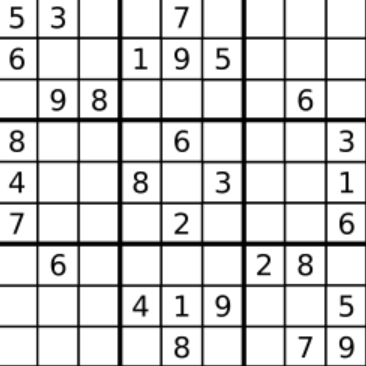2024/2/15大约 3 分钟
一、题目描述
请你判断一个9 x 9的数独是否有效。只需要根据以下规则,验证已经填入的数字是否有效即可。
- 数字
1-9在每一行只能出现一次。 - 数字
1-9在每一列只能出现一次。 - 数字
1-9在每一个以粗实线分隔的3x3宫内只能出现一次。(请参考示例图)
注意:
- 一个有效的数独(部分已被填充)不一定是可解的。
- 只需要根据以上规则,验证已经填入的数字是否有效即可。
- 空白格用
'.'表示。
示例 1
输入: board =
[["5","3",".",".","7",".",".",".","."]
,["6",".",".","1","9","5",".",".","."]
,[".","9","8",".",".",".",".","6","."]
,["8",".",".",".","6",".",".",".","3"]
,["4",".",".","8",".","3",".",".","1"]
,["7",".",".",".","2",".",".",".","6"]
,[".","6",".",".",".",".","2","8","."]
,[".",".",".","4","1","9",".",".","5"]
,[".",".",".",".","8",".",".","7","9"]]输出: true
示例 2
输入: board =
[["8","3",".",".","7",".",".",".","."]
,["6",".",".","1","9","5",".",".","."]
,[".","9","8",".",".",".",".","6","."]
,["8",".",".",".","6",".",".",".","3"]
,["4",".",".","8",".","3",".",".","1"]
,["7",".",".",".","2",".",".",".","6"]
,[".","6",".",".",".",".","2","8","."]
,[".",".",".","4","1","9",".",".","5"]
,[".",".",".",".","8",".",".","7","9"]]输出: false
解释: 除了第一行的第一个数字从5改为8以外,空格内其他数字均与示例1相同。但由于位于左上角的3x3宫内有两个8存在, 因此这个数独是无效的。
提示
board.length == 9board[i].length == 9board[i][j]是一位数字(1-9)或者'.'
相关主题
- 数组
- 哈希表
- 矩阵
二、题解
方法 1: 遍历3次
Rust
pub fn is_valid_sudoku(board: Vec<Vec<char>>) -> bool {
let len = board.len();
let mut counter = HashMap::with_capacity(len);
let is_valid = |ch: char, counter: &mut HashMap<char, i32>| {
if ch != '.' {
counter.entry(ch).and_modify(|v| *v += 1).or_insert(1);
return counter[&ch] < 2;
};
true
};
let mut is_row_valid = || {
for i in 0..len {
counter.clear();
for &ch in board[i].iter() {
if !is_valid(ch, &mut counter) {
return false;
}
}
}
true
};
if !is_row_valid() {
return false;
}
let mut is_col_valid = || {
for i in 0..len {
counter.clear();
for j in 0..len {
if !is_valid(board[j][i], &mut counter) {
return false;
}
}
}
true
};
if !is_col_valid() {
return false;
}
let mut is_sub_boxes_valid = || {
for i in 0..len {
for j in 0..len {
if i % 3 == 0 && j % 3 == 0 {
counter.clear();
for r in 0..3 {
for c in 0..3 {
if !is_valid(board[i + r][j + c], &mut counter) {
return false;
}
}
}
}
}
}
true
};
is_sub_boxes_valid()
}Java
BiPredicate<Character, Map<Character, Integer>> isValid = (ch, counter) -> {
if (ch != '.') {
counter.put(ch, counter.getOrDefault(ch, 0) + 1);
return counter.get(ch) < 2;
}
return true;
};
BiPredicate<char[][], Map<Character, Integer>> isRowValid = (board, counter) -> {
for (int i = 0; i < board.length; i++) {
counter.clear();
for (int j = 0; j < board.length; j++) {
if (!this.isValid.test(board[i][j], counter)) {
return false;
}
}
}
return true;
};
BiPredicate<char[][], Map<Character, Integer>> isColValid = (board, counter) -> {
for (int i = 0; i < board.length; i++) {
counter.clear();
for (int j = 0; j < board.length; j++) {
if (!this.isValid.test(board[j][i], counter)) {
return false;
}
}
}
return true;
};
BiPredicate<char[][], Map<Character, Integer>> isSubBoxesValid = (board, counter) -> {
for (int i = 0; i < board.length; i++) {
for (int j = 0; j < board.length; j++) {
if (i % 3 == 0 && j % 3 == 0) {
counter.clear();
for (int r = 0; r < 3; r++) {
for (int c = 0; c < 3; c++) {
if (!this.isValid.test(board[i + r][j + c], counter)) {
return false;
}
}
}
}
}
}
return true;
};
public boolean isValidSudoku(char[][] board) {
int len = board.length;
Map<Character, Integer> counter = new HashMap<>(len);
if (!this.isRowValid.test(board, counter)) {
return false;
}
if (!this.isColValid.test(board, counter)) {
return false;
}
return this.isSubBoxesValid.test(board, counter);
}方法 2: 遍历1次
Rust
pub fn is_valid_sudoku(board: Vec<Vec<char>>) -> bool {
let mut rows = [[0; 9]; 9];
let mut cols = [[0; 9]; 9];
let mut subboxes = [[[0; 3]; 3]; 9];
for i in 0..9 {
for j in 0..9 {
let ch = board[i][j];
if ch != '.' {
let idx = (ch as u8 - b'1') as usize;
rows[i][idx] += 1;
cols[j][idx] += 1;
subboxes[idx][i / 3][j / 3] += 1;
if rows[i][idx] > 1 || cols[j][idx] > 1 || subboxes[idx][i / 3][j / 3] > 1 {
return false;
}
}
}
}
true
}Java
public boolean isValidSudoku(char[][] board) {
int[][] rows = new int[9][9];
int[][] cols = new int[9][9];
int[][][] subboxes = new int[3][3][9];
for (int i = 0; i < 9; i++) {
for (int j = 0; j < 9; j++) {
char ch = board[i][j];
if (ch != '.') {
int idx = ch - '1';
rows[i][idx]++;
cols[j][idx]++;
subboxes[i / 3][j / 3][idx]++;
if (rows[i][idx] > 1 || cols[j][idx] > 1 || subboxes[i / 3][j / 3][idx] > 1) {
return false;
}
}
}
}
return true;
}